Advancements in MXene Composite Materials for Wearable Sensors: A Review
Abstract
:1. Introduction
2. MXene Composite-Based Strain Sensors
2.1. AgNWs-Based
2.2. CNTs-Based
2.3. CNFs-Based
2.4. Conductive Hydrogels-Based
3. MXene Composite-Based Pressure Sensors
3.1. AgNWs-Based
3.2. Carbon Nanomaterials-Based
3.3. CNFs-Based
3.4. Sponge-Based
4. MXene Composite-Based Gas Sensors
4.1. NO2
4.2. NH3
4.3. Acetone
4.4. Ethanol
5. Conclusions and Outlook
Author Contributions
Funding
Institutional Review Board Statement
Informed Consent Statement
Data Availability Statement
Conflicts of Interest
References
- Ates, H.C.; Nguyen, P.Q.; Gonzalez-Macia, L.; Morales-Narváez, E.; Güder, F.; Collins, J.J.; Dincer, C. End-to-end design of wearable sensors. Nat. Rev. Mater. 2022, 7, 887–907. [Google Scholar] [CrossRef] [PubMed]
- Hu, L.; Chee, P.L.; Sugiarto, S.; Yu, Y.; Shi, C.; Yan, R.; Yao, Z.; Shi, X.; Zhi, J.; Kai, D.; et al. Hydrogel-based flexible electronics. Adv. Mater. 2023, 35, 2205326. [Google Scholar] [CrossRef] [PubMed]
- Chen, H.; Zhuo, F.; Zhou, J.; Liu, Y.; Zhang, J.; Dong, S.; Liu, X.; Elmarakbi, A.; Duan, H.; Fu, Y. Advances in graphene-based flexible and wearable strain sensors. Chem. Eng. J. 2023, 464, 142576. [Google Scholar] [CrossRef]
- Shen, Z.; Liu, F.; Huang, S.; Wang, H.; Yang, C.; Hang, T.; Tao, J.; Xia, W.; Xie, X. Progress of flexible strain sensors for physiological signal monitoring. Biosens. Bioelectron. 2022, 211, 114298. [Google Scholar] [CrossRef] [PubMed]
- Shi, Z.; Meng, L.; Shi, X.; Li, H.; Zhang, J.; Sun, Q.; Liu, X.; Chen, J.; Liu, S. Morphological engineering of sensing materials for flexible pressure sensors and artificial intelligence applications. Nano-Micro Lett. 2022, 14, 141. [Google Scholar] [CrossRef] [PubMed]
- Chowdhury, A.H.; Jafarizadeh, B.; Baboukani, A.R.; Pala, N.; Wang, C. Monitoring and analysis of cardiovascular pulse waveforms using flexible capacitive and piezoresistive pressure sensors and machine learning perspective. Biosens. Bioelectron. 2023, 237, 115449. [Google Scholar] [CrossRef] [PubMed]
- Ou, L.X.; Liu, M.Y.; Zhu, L.Y.; Zhang, D.W.; Lu, H.L. Recent progress on flexible room-temperature gas sensors based on metal oxide semiconductor. Nano-Micro Lett. 2022, 14, 206. [Google Scholar] [CrossRef]
- Luo, Y.; Li, J.; Ding, Q.; Wang, H.; Liu, C.; Wu, J. Functionalized Hydrogel-Based Wearable Gas and Humidity Sensors. Nano-Micro Lett. 2023, 15, 136. [Google Scholar] [CrossRef] [PubMed]
- Yuwen, T.; Shu, D.; Zou, H.; Yang, X.; Wang, S.; Zhang, S.; Liu, Q.; Wang, X.; Wang, G.; Zhang, Y.; et al. Carbon nanotubes: A powerful bridge for conductivity and flexibility in electrochemical glucose sensors. J. Nanobiotechnol. 2023, 21, 320. [Google Scholar] [CrossRef] [PubMed]
- Zhang, L.; Song, T.; Shi, L.; Wen, N.; Wu, Z.; Sun, C.; Jiang, D.; Guo, Z. Recent progress for silver nanowires conducting film for flexible electronics. J. Nanostruct. Chem. 2021, 11, 323–341. [Google Scholar] [CrossRef] [PubMed]
- Du, K.; Zhang, D.; Zhang, S.; Tam, K.C. Advanced Functionalized Materials Based on Layer-by-Layer Assembled Natural Cellulose Nanofiber for Electrodes: A Review. Small 2023, 20, 2304739. [Google Scholar] [CrossRef]
- Yang, T.; Xia, J.; Piao, Z.; Yang, L.; Zhang, S.; Xing, Y.; Zhou, G. Graphene-based materials for flexible lithium–sulfur batteries. ACS Nano 2021, 15, 13901–13923. [Google Scholar] [CrossRef] [PubMed]
- Huang, Y.; Lu, Q.; Wu, D.; Jiang, Y.; Liu, Z.; Chen, B.; Zhu, M.; Schmidt, O.G. Flexible MXene films for batteries and beyond. Carbon Energy 2022, 4, 598–620. [Google Scholar] [CrossRef]
- Ma, C.; Ma, M.G.; Si, C.; Ji, X.X.; Wan, P. Flexible MXene-based composites for wearable devices. Adv. Funct. Mater. 2021, 31, 2009524. [Google Scholar] [CrossRef]
- Hussain, I.; Lamiel, C.; Javed, M.S.; Ahmad, M.; Sahoo, S.; Chen, X.; Qin, N.; Iqbal, S.; Gu, S.; Li, Y.; et al. MXene-based heterostructures: Current trend and development in electrochemical energy storage devices. Prog. Energ. Combust. 2023, 97, 101097. [Google Scholar] [CrossRef]
- Liu, Y.; Zhang, W.; Zheng, W. Quantum dots compete at the acme of MXene family for the optimal catalysis. Nano-Micro Lett. 2022, 14, 158. [Google Scholar] [CrossRef] [PubMed]
- Liu, Y.; Wang, Y.; Wu, N.; Han, M.; Liu, W.; Liu, J.; Zeng, Z. Diverse structural design strategies of MXene-based macrostructure for high-performance electromagnetic interference shielding. Nano-Micro Lett. 2023, 15, 240. [Google Scholar] [CrossRef] [PubMed]
- Naguib, M.; Kurtoglu, M.; Presser, V.; Lu, J.; Niu, J.; Heon, M.; Hultman, L.; Gogotsi, Y.; Barsoum, M.W. Two-dimensional nanocrystals produced by exfoliation of Ti3AlC2. Adv. Mater. 2011, 23, 4248–4253. [Google Scholar] [CrossRef] [PubMed]
- Ahmed, A.; Sharma, S.; Adak, B.; Hossain, M.M.; LaChance, A.M.; Mukhopadhyay, S.; Sun, L. Two-dimensional MXenes: New frontier of wearable and flexible electronics. InfoMat 2022, 4, e12295. [Google Scholar] [CrossRef]
- VahidMohammadi, A.; Rosen, J.; Gogotsi, Y. The world of two-dimensional carbides and nitrides (MXenes). Science 2021, 372, eabf1581. [Google Scholar] [CrossRef] [PubMed]
- Abdolhosseinzadeh, S.; Jiang, X.; Zhang, H.; Qiu, J.; Zhang, C.J. Perspectives on solution processing of two-dimensional MXenes. Mater Today 2021, 48, 214–240. [Google Scholar] [CrossRef]
- Mathis, T.S.; Maleski, K.; Goad, A.; Sarycheva, A.; Anayee, M.; Foucher, A.C.; Hantanasirisakul, K.; Shuck, C.E.; Stach, E.A.; Gogotsi, Y. Modified MAX phase synthesis for environmentally stable and highly conductive Ti3C2 MXene. ACS Nano 2021, 15, 6420–6429. [Google Scholar] [CrossRef]
- Wang, Y.; Yue, Y.; Cheng, F.; Cheng, Y.; Ge, B.; Liu, N.; Gao, Y. Ti3C2Tx MXene-based flexible piezoresistive physical sensors. ACS Nano 2022, 16, 1734–1758. [Google Scholar] [CrossRef] [PubMed]
- Cao, W.T.; Chen, F.F.; Zhu, Y.J.; Zhang, Y.G.; Jiang, Y.Y.; Ma, M.G.; Chen, F. Binary strengthening and toughening of MXene/cellulose nanofiber composite paper with nacre-inspired structure and superior electromagnetic interference shielding properties. ACS Nano 2018, 12, 4583–4593. [Google Scholar] [CrossRef] [PubMed]
- Chen, J.; Liu, F.; Abdiryim, T.; Liu, X. An overview of conductive composite hydrogels for flexible electronic devices. Adv. Compos. Hybrid Mater. 2024, 7, 35. [Google Scholar] [CrossRef]
- Yan, J.; Ma, Y.; Jia, G.; Zhao, S.; Yue, Y.; Cheng, F.; Zhang, C.; Cao, M.; Xiong, Y.; Shen, P.; et al. Bionic MXene based hybrid film design for an ultrasensitive piezoresistive pressure sensor. Chem. Eng. J. 2022, 431, 133458. [Google Scholar] [CrossRef]
- Ali, M.; Lee, D.; Chae, M.; Ahmad, I.; Kim, H.D. Advances in MXene-based synaptic devices and sensors: Review. Mater. Today Phys. 2024, 45, 101456. [Google Scholar] [CrossRef]
- Grabowski, K.; Srivatsa, S.; Vashisth, A.; Mishnaevsky, L., Jr.; Uhl, T. Recent advances in MXene-based sensors for Structural Health Monitoring applications: A review. Measurement 2022, 189, 110575. [Google Scholar] [CrossRef]
- Ahmad, N.; Rasheed, S.; Mohyuddin, A.; Fatima, B.; Nabeel, M.I.; Riaz, M.T.; Najam-ul Haq, M.; Hussain, D. 2D MXenes and their composites; design, synthesis, and environmental sensing applications. Chemosphere 2024, 352, 141280. [Google Scholar] [CrossRef] [PubMed]
- Su, E.; Wu, F.; Zhao, S.; Li, Y.; Deng, C. Layered MXene/aramid composite film for a soft and sensitive pressure sensor. ACS Appl. Mater. Interfaces 2022, 14, 15849–15858. [Google Scholar] [CrossRef] [PubMed]
- Vasseghian, Y.; Doan, V.D.; Nguyen, T.T.T.; Vo, T.T.T.; Do, H.H.; Vu, K.B.; Vu, Q.H.; Dai Lam, T.; Tran, V.A. Flexible and high-sensitivity sensor based on Ti3C2–MoS2 MXene composite for the detection of toxic gases. Chemosphere 2022, 291, 133025. [Google Scholar] [CrossRef]
- Zhao, L.; Wang, K.; Wei, W.; Wang, L.; Han, W. High-performance flexible sensing devices based on polyaniline/MXene nanocomposites. InfoMat 2019, 1, 407–416. [Google Scholar] [CrossRef]
- Liu, M.; Ding, Y.; Lu, Z.; Song, P.; Wang, Q. Layered Ti3C2Tx MXene/CuO spindles composites for NH3 detection at room-temperature. J. Alloys Compd. 2023, 938, 168563. [Google Scholar] [CrossRef]
- Pu, J.H.; Zhao, X.; Zha, X.J.; Li, W.D.; Ke, K.; Bao, R.Y.; Liu, Z.Y.; Yang, M.B.; Yang, W. A strain localization directed crack control strategy for designing MXene-based customizable sensitivity and sensing range strain sensors for full-range human motion monitoring. Nano Energy 2020, 74, 104814. [Google Scholar] [CrossRef]
- Bu, Y.; Shen, T.; Yang, W.; Yang, S.; Zhao, Y.; Liu, H.; Zheng, Y.; Liu, C.; Shen, C. Ultrasensitive strain sensor based on superhydrophobic microcracked conductive Ti3C2Tx MXene/paper for human-motion monitoring and E-skin. Sci. Bull. 2021, 66, 1849–1857. [Google Scholar] [CrossRef] [PubMed]
- Yuan, T.; Yin, R.; Li, C.; Fan, Z.; Pan, L. Ti3C2Tx MXene-based all-resistive dual-mode sensor with near-zero temperature coefficient of resistance for crosstalk-free pressure and temperature detections. Chem. Eng. J. 2024, 487, 150396. [Google Scholar] [CrossRef]
- Guo, W.; Ma, Z.; Chen, Z.; Hua, H.; Wang, D.; Hilal, M.E.; Fu, Y.; Lu, P.; Lu, J.; Zhang, Y.; et al. Thin and soft Ti3C2Tx MXene sponge structure for highly sensitive pressure sensor assisted by deep learning. Chem. Eng. J. 2024, 485, 149659. [Google Scholar] [CrossRef]
- Li, C.; Yun, T.; Tao, Y.; Lu, J.; Li, C.; Du, J.; Wang, H. Constructing high-density crack-microstructures within MXene interlayers for ultrasensitive and superhydrophobic cellulosic fibers-based sensors. Int. J. Biol. Macromol. 2024, 260, 129488. [Google Scholar] [CrossRef]
- Zhao, W.; Jiang, J.; Chen, W.; He, Y.; Lin, T.; Zhao, L. Radiation synthesis of rapidly self-healing, durable, and flexible poly (ionic liquid)/MXene gels with anti-freezing property for multi-functional strain sensors. Chem. Eng. J. 2023, 468, 143660. [Google Scholar] [CrossRef]
- Wang, W.; Lu, L.; Li, Z.; Lin, L.; Liang, Z.; Lu, X.; Xie, Y. Fingerprint-inspired strain sensor with balanced sensitivity and strain range using laser-induced graphene. ACS Appl. Mater. Interfaces 2021, 14, 1315–1325. [Google Scholar] [CrossRef]
- Jin, C.; Bai, Z. MXene-based textile sensors for wearable applications. ACS Sens. 2022, 7, 929–950. [Google Scholar] [CrossRef]
- Meng, W.; Liu, X.; Song, H.; Xie, Y.; Shi, X.; Dargusch, M.; Chen, Z.G.; Tang, Z.; Lu, S. Advances and challenges in 2D MXenes: From structures to energy storage and conversions. Nano Today 2021, 40, 101273. [Google Scholar] [CrossRef]
- Zhao, X.F.; Wen, X.H.; Zhong, S.L.; Liu, M.Y.; Liu, Y.H.; Yu, X.B.; Ma, R.G.; Zhang, D.W.; Wang, J.C.; Lu, H.L. Hollow MXene sphere-based flexible e-skin for multiplex tactile detection. ACS Appl. Mater. Interfaces 2021, 13, 45924–45934. [Google Scholar] [CrossRef] [PubMed]
- Liu, X.; Miao, J.; Fan, Q.; Zhang, W.; Zuo, X.; Tian, M.; Zhu, S.; Zhang, X.; Qu, L. Smart textile based on 3D stretchable silver nanowires/MXene conductive networks for personal healthcare and thermal management. ACS Appl. Mater. Interfaces 2021, 13, 56607–56619. [Google Scholar] [CrossRef] [PubMed]
- Chao, M.; Di, P.; Yuan, Y.; Xu, Y.; Zhang, L.; Wan, P. Flexible breathable photothermal-therapy epidermic sensor with MXene for ultrasensitive wearable human-machine interaction. Nano Energy 2023, 108, 108201. [Google Scholar] [CrossRef]
- Bian, X.; Yang, Z.; Zhang, T.; Yu, J.; Xu, G.; Chen, A.; He, Q.; Pan, J. Multifunctional flexible AgNW/MXene/PDMS composite films for efficient electromagnetic interference shielding and strain sensing. ACS Appl. Mater. Interfaces 2023, 15, 41906–41915. [Google Scholar] [CrossRef] [PubMed]
- Dong, H.; Sun, J.; Liu, X.; Jiang, X.; Lu, S. Highly sensitive and stretchable MXene/CNTs/TPU composite strain sensor with bilayer conductive structure for human motion detection. ACS Appl. Mater. Interfaces 2022, 14, 15504–15516. [Google Scholar] [CrossRef] [PubMed]
- Zhang, D.; Yin, R.; Zheng, Y.; Li, Q.; Liu, H.; Liu, C.; Shen, C. Multifunctional MXene/CNTs based flexible electronic textile with excellent strain sensing, electromagnetic interference shielding and Joule heating performances. Chem. Eng. J. 2022, 438, 135587. [Google Scholar] [CrossRef]
- Wang, H.; Zhou, R.; Li, D.; Zhang, L.; Ren, G.; Wang, L.; Liu, J.; Wang, D.; Tang, Z.; Lu, G.; et al. High-Performance Foam-Shaped Strain Sensor Based on Carbon Nanotubes and Ti3C2Tx MXene for the Monitoring of Human Activities. ACS Nano 2021, 15, 9690–9700. [Google Scholar] [CrossRef]
- Xu, W.; Hu, S.; Zhao, Y.; Zhai, W.; Chen, Y.; Zheng, G.; Dai, K.; Liu, C.; Shen, C. Nacre-inspired tunable strain sensor with synergistic interfacial interaction for sign language interpretation. Nano Energy 2021, 90, 106606. [Google Scholar] [CrossRef]
- Yang, H.; Li, J.; Xiao, X.; Wang, J.; Li, Y.; Li, K.; Li, Z.; Yang, H.; Wang, Q.; Yang, J.; et al. Topographic design in wearable MXene sensors with in-sensor machine learning for full-body avatar reconstruction. Nat. Commun. 2022, 13, 5311. [Google Scholar] [CrossRef] [PubMed]
- Geng, L.; Liu, W.; Fan, B.; Wu, J.; Shi, S.; Huang, A.; Hu, J.; Peng, X. Anisotropic double-network hydrogels integrated superior performance of strength, toughness and conductivity for flexible multi-functional sensors. Chem. Eng. J. 2023, 462, 142226. [Google Scholar] [CrossRef]
- Zhang, W.; Wang, P.L.; Ji, X.X.; Huang, L.Z.; Cao, D.Q.; Li, J.; Ma, M.G. Ultrastretchable and adhesive MXene-based hydrogel for high-performance strain sensing and self-powered application. Compos. Part A-Appl. Sci. Manuf. 2024, 177, 107957. [Google Scholar] [CrossRef]
- He, Y.; Chen, J.; Qian, Y.; Wei, Y.; Wang, C.; Ye, Z.; Liu, Y.; Chen, G. Organohydrogel based on cellulose-stabilized emulsion for electromagnetic shielding, flame retardant, and strain sensing. Carbohyd. Polym. 2022, 298, 120132. [Google Scholar] [CrossRef] [PubMed]
- Feng, Y.; Liu, H.; Zhu, W.; Guan, L.; Yang, X.; Zvyagin, A.V.; Zhao, Y.; Shen, C.; Yang, B.; Lin, Q. Muscle-inspired MXene conductive hydrogels with anisotropy and low-temperature tolerance for wearable flexible sensors and arrays. Adv. Funct. Mater. 2021, 31, 2105264. [Google Scholar] [CrossRef]
- Guo, B.; He, S.; Yao, M.; Tan, Z.; Li, X.; Liu, M.; Yu, C.; Liang, L.; Zhao, Z.; Guo, Z.; et al. MXene-containing anisotropic hydrogels strain sensors with enhanced sensing performance for human motion monitoring and wireless transmission. Chem. Eng. J. 2023, 461, 142099. [Google Scholar] [CrossRef]
- Lin, T.; Li, S.; Hu, Y.; Sheng, L.; Chen, X.; Que, X.; Peng, J.; Ma, H.; Li, J.; Zhai, M. Ultrastretchable and adhesive agarose/Ti3C2Tx-crosslinked-polyacrylamide double-network hydrogel for strain sensor. Carbohyd. Polym. 2022, 290, 119506. [Google Scholar] [CrossRef] [PubMed]
- Chae, A.; Murali, G.; Lee, S.Y.; Gwak, J.; Kim, S.J.; Jeong, Y.J.; Kang, H.; Park, S.; Lee, A.S.; Koh, D.Y.; et al. Highly Oxidation-Resistant and Self-Healable MXene-Based Hydrogels for Wearable Strain Sensor. Adv. Funct. Mater. 2023, 33, 2213382. [Google Scholar] [CrossRef]
- Wang, X.; Wang, X.; Yin, J.; Li, N.; Zhang, Z.; Xu, Y.; Zhang, L.; Qin, Z.; Jiao, T. Mechanically robust, degradable and conductive MXene-composited gelatin organohydrogel with environmental stability and self-adhesiveness for multifunctional sensor. Compos. Part B-Eng. 2022, 241, 110052. [Google Scholar] [CrossRef]
- Lee, P.; Ham, J.; Lee, J.; Hong, S.; Han, S.; Suh, Y.D.; Lee, S.E.; Yeo, J.; Lee, S.S.; Lee, D.; et al. Highly stretchable or transparent conductor fabrication by a hierarchical multiscale hybrid nanocomposite. Adv. Funct. Mater. 2014, 24, 5671–5678. [Google Scholar] [CrossRef]
- Wang, Q.; Sheng, H.; Lv, Y.; Liang, J.; Liu, Y.; Li, N.; Xie, E.; Su, Q.; Ershad, F.; Lan, W.; et al. A skin-mountable hyperthermia patch based on metal nanofiber network with high transparency and low resistivity toward subcutaneous tumor treatment. Adv. Funct. Mater. 2022, 32, 2111228. [Google Scholar] [CrossRef]
- Liang, C.; Ruan, K.; Zhang, Y.; Gu, J. Multifunctional flexible electromagnetic interference shielding silver nanowires/cellulose films with excellent thermal management and joule heating performances. ACS Appl. Mater. Interfaces 2020, 12, 18023–18031. [Google Scholar] [CrossRef] [PubMed]
- Luo, J.; Gao, S.; Luo, H.; Wang, L.; Huang, X.; Guo, Z.; Lai, X.; Lin, L.; Li, R.K.; Gao, J. Superhydrophobic and breathable smart MXene-based textile for multifunctional wearable sensing electronics. Chem. Eng. J. 2021, 406, 126898. [Google Scholar] [CrossRef]
- Liu, C.; Ma, Y.; Xie, Y.; Zou, J.; Wu, H.; Peng, S.; Qian, W.; He, D.; Zhang, X.; Li, B.W.; et al. Enhanced electromagnetic shielding and thermal management properties in MXene/aramid nanofiber films fabricated by intermittent filtration. ACS Appl. Mater. Interfaces 2023, 15, 4516–4526. [Google Scholar] [CrossRef] [PubMed]
- Heng, W.; Weihua, L.; Bachagha, K. Review on design strategies and applications of flexible cellulose-carbon nanotube functional composites. Carbohyd. Polym. 2023, 321, 121306. [Google Scholar] [CrossRef] [PubMed]
- Ma, Z.; Kang, S.; Ma, J.; Shao, L.; Zhang, Y.; Liu, C.; Wei, A.; Xiang, X.; Wei, L.; Gu, J. Ultraflexible and mechanically strong double-layered aramid nanofiber–Ti3C2Tx mxene/silver nanowire nanocomposite papers for high-performance electromagnetic interference shielding. ACS Nano 2020, 14, 8368–8382. [Google Scholar] [CrossRef] [PubMed]
- Zhang, L.; Hao, Q.; Liu, J.; Zhou, J.; Zhang, W.; Li, Y. Rolling up of 2D nanosheets into 1D Nanoscrolls: Visible-Light-Activated chemiresistors based on surface modified indium selenide with enhanced sensitivity and stability. Chem. Eng. J. 2022, 446, 136937. [Google Scholar] [CrossRef]
- Zhu, J.; Tao, J.; Yan, W.; Song, W. Pathways towards wearable and high-performance sensors based on hydrogels: Toughening networks and conductive networks. Natl. Sci. Rev. 2023, 10, nwad180. [Google Scholar] [CrossRef] [PubMed]
- Zhang, C.J.; Pinilla, S.; McEvoy, N.; Cullen, C.P.; Anasori, B.; Long, E.; Park, S.H.; Seral-Ascaso, A.; Shmeliov, A.; Krishnan, D.; et al. Oxidation stability of colloidal two-dimensional titanium carbides (MXenes). Chem. Mater. 2017, 29, 4848–4856. [Google Scholar] [CrossRef]
- Heckler, J.E.; Neher, G.R.; Mehmood, F.; Lioi, D.B.; Pachter, R.; Vaia, R.; Kennedy, W.J.; Nepal, D. Surface Functionalization of Ti3C2Tx MXene Nanosheets with Catechols: Implication for Colloidal Processing. Langmuir 2021, 37, 5447–5456. [Google Scholar] [CrossRef] [PubMed]
- Hwang, J.; Kim, Y.; Yang, H.; Oh, J.H. Fabrication of hierarchically porous structured PDMS composites and their application as a flexible capacitive pressure sensor. Compos. Part B-Eng. 2021, 211, 108607. [Google Scholar] [CrossRef]
- Sharma, S.; Chhetry, A.; Zhang, S.; Yoon, H.; Park, C.; Kim, H.; Sharifuzzaman, M.; Hui, X.; Park, J.Y. Hydrogen-bond-triggered hybrid nanofibrous membrane-based wearable pressure sensor with ultrahigh sensitivity over a broad pressure range. ACS Nano 2021, 15, 4380–4393. [Google Scholar] [CrossRef] [PubMed]
- Tang, C.Y.; Zhao, X.; Jia, J.; Wang, S.; Zha, X.J.; Yin, B.; Ke, K.; Bao, R.Y.; Liu, Z.Y.; Wang, Y.; et al. Low-entropy structured wearable film sensor with piezoresistive-piezoelectric hybrid effect for 3D mechanical signal screening. Nano Energy 2021, 90, 106603. [Google Scholar] [CrossRef]
- Wu, Y.; Ma, Y.; Zheng, H.; Ramakrishna, S. Piezoelectric materials for flexible and wearable electronics: A review. Mater. Design 2021, 211, 110164. [Google Scholar] [CrossRef]
- Cai, Y.W.; Zhang, X.N.; Wang, G.G.; Li, G.Z.; Zhao, D.Q.; Sun, N.; Li, F.; Zhang, H.Y.; Han, J.C.; Yang, Y. A flexible ultra-sensitive triboelectric tactile sensor of wrinkled PDMS/MXene composite films for E-skin. Nano Energy 2021, 81, 105663. [Google Scholar] [CrossRef]
- Yan, Z.; Wang, L.; Xia, Y.; Qiu, R.; Liu, W.; Wu, M.; Zhu, Y.; Zhu, S.; Jia, C.; Zhu, M.; et al. Flexible high-resolution triboelectric sensor array based on patterned laser-induced graphene for self-powered real-time tactile sensing. Adv. Funct. Mater. 2021, 31, 2100709. [Google Scholar] [CrossRef]
- Yang, T.; Deng, W.; Chu, X.; Wang, X.; Hu, Y.; Fan, X.; Song, J.; Gao, Y.; Zhang, B.; Tian, G.; et al. Hierarchically microstructure-bioinspired flexible piezoresistive bioelectronics. ACS Nano 2021, 15, 11555–11563. [Google Scholar] [CrossRef] [PubMed]
- Liu, H.; Chen, X.; Zheng, Y.; Zhang, D.; Zhao, Y.; Wang, C.; Pan, C.; Liu, C.; Shen, C. Lightweight, superelastic, and hydrophobic polyimide nanofiber/MXene composite aerogel for wearable piezoresistive sensor and oil/water separation applications. Adv. Funct. Mater. 2021, 31, 2008006. [Google Scholar] [CrossRef]
- Ruth, S.R.A.; Feig, V.R.; Tran, H.; Bao, Z. Microengineering pressure sensor active layers for improved performance. Adv. Funct. Mater. 2020, 30, 2003491. [Google Scholar] [CrossRef]
- Kwak, Y.H.; Kim, W.; Park, K.B.; Kim, K.; Seo, S. Flexible heartbeat sensor for wearable device. Biosens. Bioelectron. 2017, 94, 250–255. [Google Scholar] [CrossRef] [PubMed]
- Jian, M.; Wang, C.; Wang, Q.; Wang, H.; Xia, K.; Yin, Z.; Zhang, M.; Liang, X.; Zhang, Y. Advanced Carbon Materials for Flexible and Wearable Sensors. Sci. China Mater. 2017, 60, 1026–1062. [Google Scholar] [CrossRef]
- Nan, J.; Guo, X.; Xiao, J.; Li, X.; Chen, W.; Wu, W.; Liu, H.; Wang, Y.; Wu, M.; Wang, G. Nanoengineering of 2D MXene-based materials for energy storage applications. Small 2021, 17, 1902085. [Google Scholar] [CrossRef] [PubMed]
- Guo, Y.; Zhong, M.; Fang, Z.; Wan, P.; Yu, G. A wearable transient pressure sensor made with MXene nanosheets for sensitive broad-range human–machine interfacing. Nano Lett. 2019, 19, 1143–1150. [Google Scholar] [CrossRef] [PubMed]
- Cheng, Y.; Ma, Y.; Li, L.; Zhu, M.; Yue, Y.; Liu, W.; Wang, L.; Jia, S.; Li, C.; Qi, T.; et al. Bioinspired microspines for a high-performance spray Ti3C2Tx MXene-based piezoresistive sensor. ACS Nano 2020, 14, 2145–2155. [Google Scholar] [CrossRef] [PubMed]
- Gao, Y.; Yan, C.; Huang, H.; Yang, T.; Tian, G.; Xiong, D.; Chen, N.; Chu, X.; Zhong, S.; Deng, W.; et al. Microchannel-confined MXene based flexible piezoresistive multifunctional micro-force sensor. Adv. Funct. Mater. 2020, 30, 1909603. [Google Scholar] [CrossRef]
- Zheng, X.; Cao, W.; Hong, X.; Zou, L.; Liu, Z.; Wang, P.; Li, C. Versatile Electronic Textile Enabled by a Mixed-Dimensional Assembly Strategy. Small 2023, 19, 2208134. [Google Scholar] [CrossRef] [PubMed]
- Zheng, X.; Zhang, S.; Zhou, M.; Lu, H.; Guo, S.; Zhang, Y.; Li, C.; Tan, S.C. MXene Functionalized, Highly Breathable and Sensitive Pressure Sensors with Multi-Layered Porous Structure. Adv. Funct. Mater. 2023, 33, 2214880. [Google Scholar] [CrossRef]
- Qin, L.; Yang, D.; Zhang, M.; Zhao, T.; Luo, Z.; Yu, Z.Z. Superelastic and ultralight electrospun carbon nanofiber/MXene hybrid aerogels with anisotropic microchannels for pressure sensing and energy storage. J. Colloid Interface Sci. 2021, 589, 264–274. [Google Scholar] [CrossRef] [PubMed]
- Li, Z.; Feng, D.; Li, B.; Zhao, W.; Xie, D.; Mei, Y.; Liu, P. Ultra-Wide Range, High Sensitivity Piezoresistive Sensor Based on Triple Periodic Minimum Surface Construction. Small 2023, 19, 2301378. [Google Scholar] [CrossRef] [PubMed]
- Yang, Z.; Li, H.; Zhang, S.; Lai, X.; Zeng, X. Superhydrophobic MXene@ carboxylated carbon nanotubes/carboxymethyl chitosan aerogel for piezoresistive pressure sensor. Chem. Eng. J. 2021, 425, 130462. [Google Scholar] [CrossRef]
- Xu, T.; Song, Q.; Liu, K.; Liu, H.; Pan, J.; Liu, W.; Dai, L.; Zhang, M.; Wang, Y.; Si, C.; et al. Nanocellulose-assisted construction of multifunctional MXene-based aerogels with engineering biomimetic texture for pressure sensor and compressible electrode. Nano-Micro Lett. 2023, 15, 98. [Google Scholar] [CrossRef] [PubMed]
- Su, T.; Liu, N.; Gao, Y.; Lei, D.; Wang, L.; Ren, Z.; Zhang, Q.; Su, J.; Zhang, Z. MXene/cellulose nanofiber-foam based high performance degradable piezoresistive sensor with greatly expanded interlayer distances. Nano Energy 2021, 87, 106151. [Google Scholar] [CrossRef]
- Wei, L.; Wu, Z.; Tang, S.; Qin, X.; Xiong, Y.; Li, J.; Ruiz-Hitzky, E.; Wang, X. Tracheid-inspired nanoarchitectured carbon-based aerogels with ultra-compressibility for wearable piezoresistive sensors. Carbon 2023, 203, 386–396. [Google Scholar] [CrossRef]
- Chen, T.; Liu, Z.; Zhao, G.; Qin, Z.; Zheng, P.; Aladejana, J.T.; Tang, Z.; Weng, M.; Peng, X.; Chang, J. Piezoresistive Sensor Containing Lamellar MXene-Plant Fiber Sponge Obtained with Aqueous MXene Ink. ACS Appl. Mater. Interfaces 2022, 14, 51361–51372. [Google Scholar] [CrossRef] [PubMed]
- Li, X.; Li, X.; Liu, T.; Lu, Y.; Shang, C.; Ding, X.; Zhang, J.; Feng, Y.; Xu, F.J. Wearable, washable, and highly sensitive piezoresistive pressure sensor based on a 3D sponge network for real-time monitoring human body activities. ACS Appl. Mater. Interfaces 2021, 13, 46848–46857. [Google Scholar] [CrossRef] [PubMed]
- Li, L.; Cheng, Y.; Cao, H.; Liang, Z.; Liu, Z.; Yan, S.; Li, L.; Jia, S.; Wang, J.; Gao, Y. MXene/rGO/PS spheres multiple physical networks as high-performance pressure sensor. Nano Energy 2022, 95, 106986. [Google Scholar] [CrossRef]
- Xia, H.; Wang, L.; Zhang, H.; Wang, Z.; Zhu, L.; Cai, H.; Ma, Y.; Yang, Z.; Zhang, D. MXene/PPy@ PDMS sponge-based flexible pressure sensor for human posture recognition with the assistance of a convolutional neural network in deep learning. Microsyst. Nanoeng. 2023, 9, 155. [Google Scholar] [CrossRef] [PubMed]
- Li, W.; Jin, X.; Han, X.; Li, Y.; Wang, W.; Lin, T.; Zhu, Z. Synergy of Porous Structure and Microstructure in Piezoresistive Material for High-Performance and Flexible Pressure Sensors. ACS Appl. Mater. Interfaces 2021, 13, 19211–19220. [Google Scholar] [CrossRef] [PubMed]
- Xing, Y.; Wan, Y.; Wu, Z.; Wang, J.; Jiao, S.; Liu, L. Multilayer Ultrathin MXene@AgNW@MoS2 Composite Film for High-Efficiency Electromagnetic Shielding. ACS Appl. Mater. Interfaces 2023, 15, 5787–5797. [Google Scholar] [CrossRef] [PubMed]
- Liu, H.; Huang, Z.; Chen, T.; Su, X.; Liu, Y.; Fu, R. Construction of 3D MXene/Silver nanowires aerogels reinforced polymer composites for extraordinary electromagnetic interference shielding and thermal conductivity. Chem. Eng. J. 2022, 427, 131540. [Google Scholar] [CrossRef]
- Li, Z.; Feng, D.; Li, B.; Xie, D.; Mei, Y. FDM printed MXene/MnFe2O4/MWCNTs reinforced TPU composites with 3D Voronoi structure for sensor and electromagnetic shielding applications. Compos. Sci. Technol. 2023, 231, 109803. [Google Scholar] [CrossRef]
- Sun, H.; Bu, Y.; Liu, H.; Wang, J.; Yang, W.; Li, Q.; Guo, Z.; Liu, C.; Shen, C. Superhydrophobic conductive rubber band with synergistic dual conductive layer for wide-range sensitive strain sensor. Sci. Bull. 2022, 67, 1669–1678. [Google Scholar] [CrossRef] [PubMed]
- Bai, N.; Wang, L.; Xue, Y.; Wang, Y.; Hou, X.; Li, G.; Zhang, Y.; Cai, M.; Zhao, L.; Guan, F.; et al. Graded interlocks for iontronic pressure sensors with high sensitivity and high linearity over a broad range. ACS Nano 2022, 16, 4338–4347. [Google Scholar] [CrossRef] [PubMed]
- Qin, Z.; Lv, Y.; Fang, X.; Zhao, B.; Niu, F.; Min, L.; Pan, K. Ultralight polypyrrole crosslinked nanofiber aerogel for highly sensitive piezoresistive sensor. Chem. Eng. J. 2022, 427, 131650. [Google Scholar] [CrossRef]
- Wang, S.; Gao, F.; Hu, Y.; Zhang, S.; Shang, H.; Ge, C.; Tan, B.; Zhang, X.; Zhang, J.; Hu, P. Skin-inspired tactile sensor based on gradient pore structure enable broad range response and ultrahigh pressure resolution. Chem. Eng. J. 2022, 443, 136446. [Google Scholar] [CrossRef]
- Huang, H.; Cui, J.; Liu, G.; Bi, R.; Zhang, L. Carbon-coated MoSe2/MXene hybrid nanosheets for superior potassium storage. ACS Nano 2019, 13, 3448–3456. [Google Scholar] [CrossRef] [PubMed]
- Chen, Z.; Hu, Y.; Zhuo, H.; Liu, L.; Jing, S.; Zhong, L.; Peng, X.; Sun, R.c. Compressible, elastic, and pressure-sensitive carbon aerogels derived from 2D titanium carbide nanosheets and bacterial cellulose for wearable sensors. Chem. Mater. 2019, 31, 3301–3312. [Google Scholar] [CrossRef]
- Tian, W.; VahidMohammadi, A.; Reid, M.S.; Wang, Z.; Ouyang, L.; Erlandsson, J.; Pettersson, T.; Wågberg, L.; Beidaghi, M.; Hamedi, M.M. Multifunctional nanocomposites with high strength and capacitance using 2D MXene and 1D nanocellulose. Adv. Mater. 2019, 31, 1902977. [Google Scholar] [CrossRef] [PubMed]
- Yue, Y.; Liu, N.; Liu, W.; Li, M.; Ma, Y.; Luo, C.; Wang, S.; Rao, J.; Hu, X.; Su, J.; et al. 3D hybrid porous Mxene-sponge network and its application in piezoresistive sensor. Nano Energy 2018, 50, 79–87. [Google Scholar] [CrossRef]
- Tang, Y.; Zhao, Y.; Liu, H. Room-temperature semiconductor gas sensors: Challenges and opportunities. ACS Sens. 2022, 7, 3582–3597. [Google Scholar] [CrossRef] [PubMed]
- Liu, J.; Huang, H.; Zhao, H.; Yan, X.; Wu, S.; Li, Y.; Wu, M.; Chen, L.; Yang, X.; Su, B.L. Enhanced gas sensitivity and selectivity on aperture-controllable 3D interconnected macro–mesoporous ZnO nanostructures. ACS Appl. Mater. Interfaces 2016, 8, 8583–8590. [Google Scholar] [CrossRef] [PubMed]
- Kim, H.J.; Lee, J.H. Highly sensitive and selective gas sensors using p-type oxide semiconductors: Overview. Sens. Actuators B-Chem. 2014, 192, 607–627. [Google Scholar] [CrossRef]
- Kim, H.W.; Na, H.G.; Kwon, Y.J.; Kang, S.Y.; Choi, M.S.; Bang, J.H.; Wu, P.; Kim, S.S. Microwave-assisted synthesis of graphene–SNO2 nanocomposites and their applications in gas sensors. ACS Appl. Mater. Interfaces 2017, 9, 31667–31682. [Google Scholar] [CrossRef] [PubMed]
- Ma, J.; Ren, Y.; Zhou, X.; Liu, L.; Zhu, Y.; Cheng, X.; Xu, P.; Li, X.; Deng, Y.; Zhao, D. Pt nanoparticles sensitized ordered mesoporous WO3 semiconductor: Gas sensing performance and mechanism study. Adv. Funct. Mater. 2018, 28, 1705268. [Google Scholar] [CrossRef]
- Sarycheva, A.; Makaryan, T.; Maleski, K.; Satheeshkumar, E.; Melikyan, A.; Minassian, H.; Yoshimura, M.; Gogotsi, Y. Two-dimensional titanium carbide (MXene) as surface-enhanced Raman scattering substrate. J. Phys. Chem. C 2017, 121, 19983–19988. [Google Scholar] [CrossRef]
- Lee, E.; VahidMohammadi, A.; Prorok, B.C.; Yoon, Y.S.; Beidaghi, M.; Kim, D.J. Room temperature gas sensing of two-dimensional titanium carbide (MXene). ACS Appl. Mater. Interfaces 2017, 9, 37184–37190. [Google Scholar] [CrossRef] [PubMed]
- Wang, D.; Zhang, D.; Yang, Y.; Mi, Q.; Zhang, J.; Yu, L. Multifunctional latex/polytetrafluoroethylene-based triboelectric nanogenerator for self-powered organ-like MXene/metal–organic framework-derived CuO nanohybrid ammonia sensor. ACS Nano 2021, 15, 2911–2919. [Google Scholar] [CrossRef] [PubMed]
- Quan, W.; Shi, J.; Luo, H.; Fan, C.; Lv, W.; Chen, X.; Zeng, M.; Yang, J.; Hu, N.; Su, Y.; et al. Fully Flexible MXene-based Gas Sensor on Paper for Highly Sensitive Room-Temperature Nitrogen Dioxide Detection. ACS Sens. 2023, 8, 103–113. [Google Scholar] [CrossRef] [PubMed]
- Yang, Z.; Jiang, L.; Wang, J.; Liu, F.; He, J.; Liu, A.; Lv, S.; You, R.; Yan, X.; Sun, P.; et al. Flexible resistive NO2 gas sensor of three-dimensional crumpled MXene Ti3C2Tx/ZnO spheres for room temperature application. Sens. Actuators B-Chem. 2021, 326, 128828. [Google Scholar] [CrossRef]
- Zhang, W.; Wang, W.; Wang, Y.; Sun, L.; Sun, Y.; Hu, J. Au nanoparticles decorated flower-like SnS2/Ti3C2 MXene microcomposite for high performance NO2 sensing at room temperature. Appl. Surf. Sci. 2023, 637, 157957. [Google Scholar] [CrossRef]
- Gasso, S.; Sohal, M.K.; Mahajan, A. MXene modulated SnO2 gas sensor for ultra-responsive room-temperature detection of NO2. Sens. Actuators B-Chem. 2022, 357, 131427. [Google Scholar] [CrossRef]
- Wen, X.; Cai, Y.; Nie, X.; Xiong, J.; Wang, Y.; Song, H.; Li, Z.; Shen, Y.; Li, C. PSS-doped Polyaniline (PANI) nanoparticle/Ti3C2Tx composites for conductometric flexible ammonia gas sensors operated at room temperature. Sens. Actuators B-Chem. 2023, 374, 132788. [Google Scholar] [CrossRef]
- Cai, Y.; Wang, Y.; Wen, X.; Xiong, J.; Song, H.; Li, Z.; Zu, D.; Shen, Y.; Li, C. Ti3C2Tx MXene/urchin-like Polyaniline (PANI) hollow nanosphere composite for high performance flexible ammonia gas sensor. Anal. Chim. Acta 2022, 1225, 340256. [Google Scholar] [CrossRef] [PubMed]
- Yang, R.; Zhang, J.; Liu, J.; Li, G.; Qiao, Y.; Zhang, X.; Gao, J.; Lu, H. Polyaniline (PANI)/Ti3C2Tx composite nanofiber-based flexible conductometric sensor for the detection of NH3 at room temperature. Sens. Actuators B-Chem. 2023, 392, 134128. [Google Scholar] [CrossRef]
- Liu, M.; Wang, Z.; Song, P.; Yang, Z.; Wang, Q. Flexible MXene/rGO/CuO hybrid aerogels for high performance acetone sensing at room temperature. Sens. Actuators B-Chem. 2021, 340, 129946. [Google Scholar] [CrossRef]
- Li, X.; Pan, J.; Wu, Y.; Xing, H.; An, Z.; Shi, Z.; Lv, J.; Zhang, F.; Jiang, J.; Wang, D.; et al. MXene-based wireless facemask enabled wearable breath acetone detection for lipid metabolic monitoring. Biosens. Bioelectron. 2023, 222, 114945. [Google Scholar] [CrossRef] [PubMed]
- Wang, Z.; Wang, F.; Hermawan, A.; Asakura, Y.; Hasegawa, T.; Kumagai, H.; Kato, H.; Kakihana, M.; Zhu, J.; Yin, S. SnO-SNO2 modified two-dimensional MXene Ti3C2Tx for acetone gas sensor working at room temperature. J. Mater. Sci. Technol. 2021, 73, 128–138. [Google Scholar] [CrossRef]
- Wu, Q.; Feng, Z.; Wang, Z.; Peng, Z.; Zhang, L.; Li, Y. Visual chemiresistive dual-mode sensing platform based on SnS2/Ti3C2 MXene Schottky junction for acetone detection at room temperature. Talanta 2023, 253, 124063. [Google Scholar] [CrossRef]
- Wang, D.; Zhang, D.; Tang, M.; Zhang, H.; Chen, F.; Wang, T.; Li, Z.; Zhao, P. Rotating triboelectric-electromagnetic nanogenerator driven by tires for self-powered MXene-based flexible wearable electronics. Chem. Eng. J. 2022, 446, 136914. [Google Scholar] [CrossRef]
- Wu, G.; Du, H.; Pakravan, K.; Kim, W.; Cha, Y.L.; Beidaghi, M.; Zhang, X.; Pan, X.; Kim, D.J. Wearable room-temperature ethanol sensor based on Ti3C2Tx/Polypyrrole functionalized face mask for drunk driving monitoring. Carbon 2024, 216, 118565. [Google Scholar] [CrossRef]
- Gu, D.; Liu, W.; Wang, J.; Yu, J.; Zhang, J.; Huang, B.; Rumyantseva, M.N.; Li, X. Au functionalized SnS2 nanosheets based chemiresistive NO2 sensors. Chemosensors 2022, 10, 165. [Google Scholar] [CrossRef]
- Zhao, Q.; Zhou, W.; Zhang, M.; Wang, Y.; Duan, Z.; Tan, C.; Liu, B.; Ouyang, F.; Yuan, Z.; Tai, H.; et al. Edge-enriched Mo2TiC2Tx/MoS2 heterostructure with coupling interface for selective NO2 monitoring. Adv. Funct. Mater. 2022, 32, 2203528. [Google Scholar] [CrossRef]
- Sun, Q.; Gong, Z.; Zhang, Y.; Hao, J.; Zheng, S.; Lu, W.; Cui, Y.; Liu, L.; Wang, Y. Synergically engineering defect and interlayer in SnS2 for enhanced room-temperature NO2 sensing. J. Hazard. Mater. 2022, 421, 126816. [Google Scholar] [CrossRef] [PubMed]
- Kumar, A.; Sharma, N.; Gutal, A.P.; Kumar, D.; Kumar, P.; Paranjothy, M.; Kumar, M. Growth and NO2 gas sensing mechanisms of vertically aligned 2D SnS2 flakes by CVD: Experimental and DFT studies. Sens. Actuators B-Chem. 2022, 353, 131078. [Google Scholar] [CrossRef]
- Kim, Y.H.; Phan, D.T.; Ahn, S.; Nam, K.H.; Park, C.M.; Jeon, K.J. Two-dimensional SnS2 materials as high-performance NO2 sensors with fast response and high sensitivity. Sens. Actuators B-Chem. 2018, 255, 616–621. [Google Scholar] [CrossRef]
- Wang, T.; Wang, Y.; Fan, W.; Wu, R.; Liang, Q.; Hao, J. Boosting room-temperature NO2 detection via in-situ interfacial engineering on Ag2S/SnS2 heterostructures. J. Hazard. Mater. 2022, 434, 128782. [Google Scholar] [CrossRef] [PubMed]
- Wu, J.; Wu, Z.; Ding, H.; Wei, Y.; Huang, W.; Yang, X.; Li, Z.; Qiu, L.; Wang, X. Flexible, 3D SnS2/Reduced graphene oxide heterostructured NO2 sensor. Sens. Actuators B-Chem. 2020, 305, 127445. [Google Scholar] [CrossRef]
- Ashida, Y.; Arashiba, K.; Nakajima, K.; Nishibayashi, Y. Molybdenum-catalysed ammonia production with samarium diiodide and alcohols or water. Nature 2019, 568, 536–540. [Google Scholar] [CrossRef] [PubMed]
- Xiao, Y.; Liu, Y.; Kang, S.; Cui, M.; Xu, H. Development of pH-responsive antioxidant soy protein isolate films incorporated with cellulose nanocrystals and curcumin nanocapsules to monitor shrimp freshness. Food Hydrocoll. 2021, 120, 106893. [Google Scholar] [CrossRef]
- Zeng, X.; Liu, R.; Li, Y.; Li, J.; Zhao, Q.; Li, X.; Bao, J. Excessive ammonia inhalation causes liver damage and dysfunction by altering gene networks associated with oxidative stress and immune function. Ecotoxicol. Environ. Saf. 2021, 217, 112203. [Google Scholar] [CrossRef] [PubMed]
- Zheng, J.; Pang, K.; Liu, X.; Li, S.; Song, R.; Liu, Y.; Tang, Z. Integration and synergy of organic single crystals and metal–organic frameworks in core–shell heterostructures enables outstanding gas selectivity for detection. Adv. Funct. Mater. 2020, 30, 2005727. [Google Scholar] [CrossRef]
- Kumar, V.; Mirzaei, A.; Bonyani, M.; Kim, K.H.; Kim, H.W.; Kim, S.S. Advances in electrospun nanofiber fabrication for polyaniline (Polyaniline (PANI))-based chemoresistive sensors for gaseous ammonia. TrAC-Trends Anal. Chem. 2020, 129, 115938. [Google Scholar] [CrossRef]
- Zhang, W.; Li, G.; She, C.; Cheng, J.; Li, H.; Liu, S.; Jing, C.; Cheng, Y.; Chu, J. High performance tube sensor based on Polyaniline (PANI)/Eu3+ nanofiber for low-volume NH3 detection. Anal. Chim. Acta 2020, 1093, 115–122. [Google Scholar] [CrossRef] [PubMed]
- Ranka, P.; Sethi, V.; Contractor, A.Q. One step electrodeposition of composite of Polyaniline (PANI)-PSS tubules with TiO2 nanoparticles and application as electronic sensor device. Sens. Actuators B-Chem. 2018, 261, 11–21. [Google Scholar] [CrossRef]
- Wang, G.; Fu, Z.; Wang, T.; Lei, W.; Sun, P.; Sui, Y.; Zou, B. A rational design of hollow nanocages Ag@ CuO-TiO2 for enhanced acetone sensing performance. Sens. Actuators B-Chem. 2019, 295, 70–78. [Google Scholar] [CrossRef]
- Zhou, T.; Chen, S.; Wang, X.; Xie, C.; Zeng, D. Catalytic activation of cobalt doping sites in ZIF-71-coated ZnO nanorod arrays for enhancing gas-sensing performance to acetone. ACS Appl. Mater. Interfaces 2020, 12, 48948–48956. [Google Scholar] [CrossRef] [PubMed]
- Guntner, A.T.; Abegg, S.; Konigstein, K.; Gerber, P.A.; Schmidt-Trucksass, A.; Pratsinis, S.E. Breath sensors for health monitoring. ACS Sens. 2019, 4, 268–280. [Google Scholar] [CrossRef] [PubMed]
- Xie, Y.; Xing, R.; Li, Q.; Xu, L.; Song, H. Three-dimensional ordered ZnO–CuO inverse opals toward low concentration acetone detection for exhaled breath sensing. Sens. Actuators B-Chem. 2015, 211, 255–262. [Google Scholar] [CrossRef]
- Liu, M.; Wang, Z.; Song, P.; Yang, Z.; Wang, Q. In2O3 nanocubes/Ti3C2Tx MXene composites for enhanced methanol gas sensing properties at room temperature. Ceram. Int. 2021, 47, 23028–23037. [Google Scholar] [CrossRef]
- Yang, Z.; Zou, H.; Zhang, Y.; Liu, F.; Wang, J.; Lv, S.; Jiang, L.; Wang, C.; Yan, X.; Sun, P.; et al. The Introduction of Defects in Ti3C2Tx and Ti3C2Tx-Assisted Reduction of Graphene Oxide for Highly Selective Detection of ppb-Level NO2. Adv. Funct. Mater. 2022, 32, 2108959. [Google Scholar] [CrossRef]
- Burman, D.; Raha, H.; Manna, B.; Pramanik, P.; Guha, P.K. Substitutional doping of MoS2 for superior gas-sensing applications: A proof of concept. ACS Sens. 2021, 6, 3398–3408. [Google Scholar] [CrossRef] [PubMed]
- Cho, B.; Yoon, J.; Lim, S.K.; Kim, A.R.; Kim, D.H.; Park, S.G.; Kwon, J.D.; Lee, Y.J.; Lee, K.H.; Lee, B.H.; et al. Chemical sensing of 2D graphene/MoS2 heterostructure device. ACS Appl. Mater. Interfaces 2015, 7, 16775–16780. [Google Scholar] [CrossRef] [PubMed]
- Kim, S.J.; Koh, H.J.; Ren, C.E.; Kwon, O.; Maleski, K.; Cho, S.Y.; Anasori, B.; Kim, C.K.; Choi, Y.K.; Kim, J.; et al. Metallic Ti3C2Tx MXene gas sensors with ultrahigh signal-to-noise ratio. ACS Nano 2018, 12, 986–993. [Google Scholar] [CrossRef] [PubMed]
- Zhang, S.; Zahed, M.A.; Sharifuzzaman, M.; Yoon, S.; Hui, X.; Barman, S.C.; Sharma, S.; Yoon, H.S.; Park, C.; Park, J.Y. A wearable battery-free wireless and skin-interfaced microfluidics integrated electrochemical sensing patch for on-site biomarkers monitoring in human perspiration. Biosens. Bioelectron. 2021, 175, 112844. [Google Scholar] [CrossRef] [PubMed]
- Li, Y.; Liu, K.; Wang, B.; Liu, Z.; Yang, C.; Wang, J.; Ma, X.; Li, H.; Sun, C. Engineering DNAzyme strategies for fluorescent detection of lead ions based on RNA cleavage-propelled signal amplification. J. Hazard. Mater. 2022, 440, 129712. [Google Scholar] [CrossRef] [PubMed]
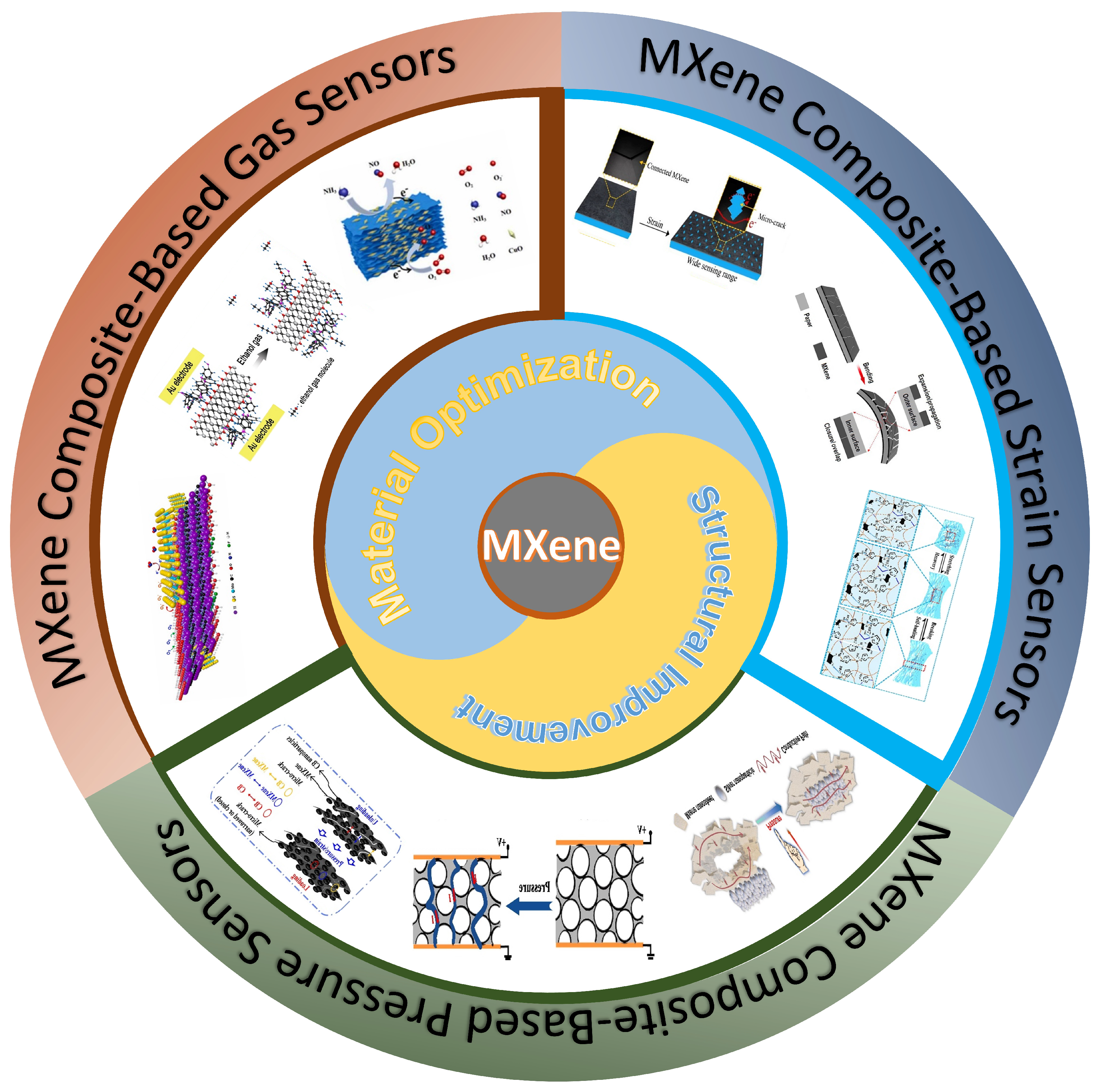
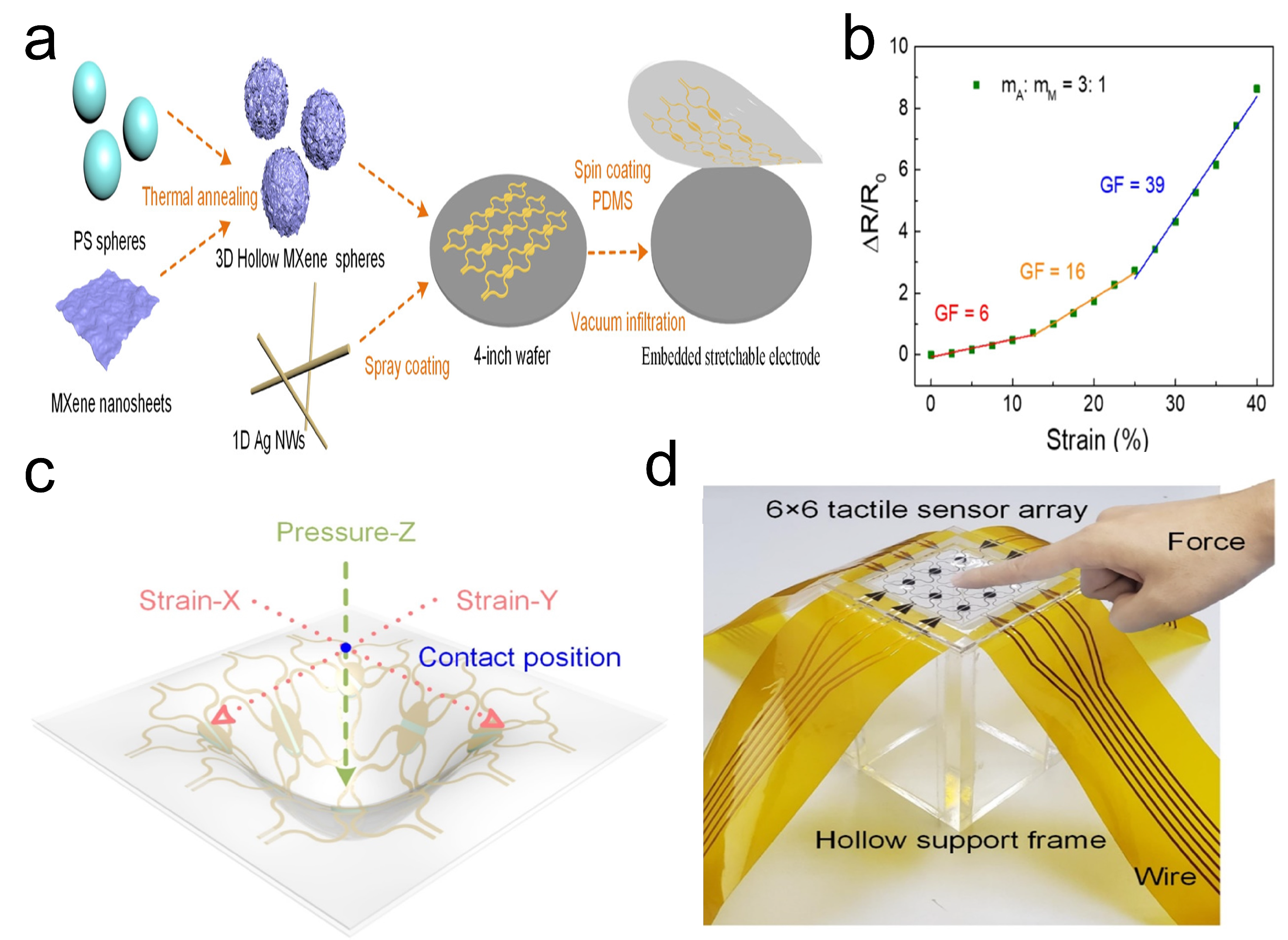

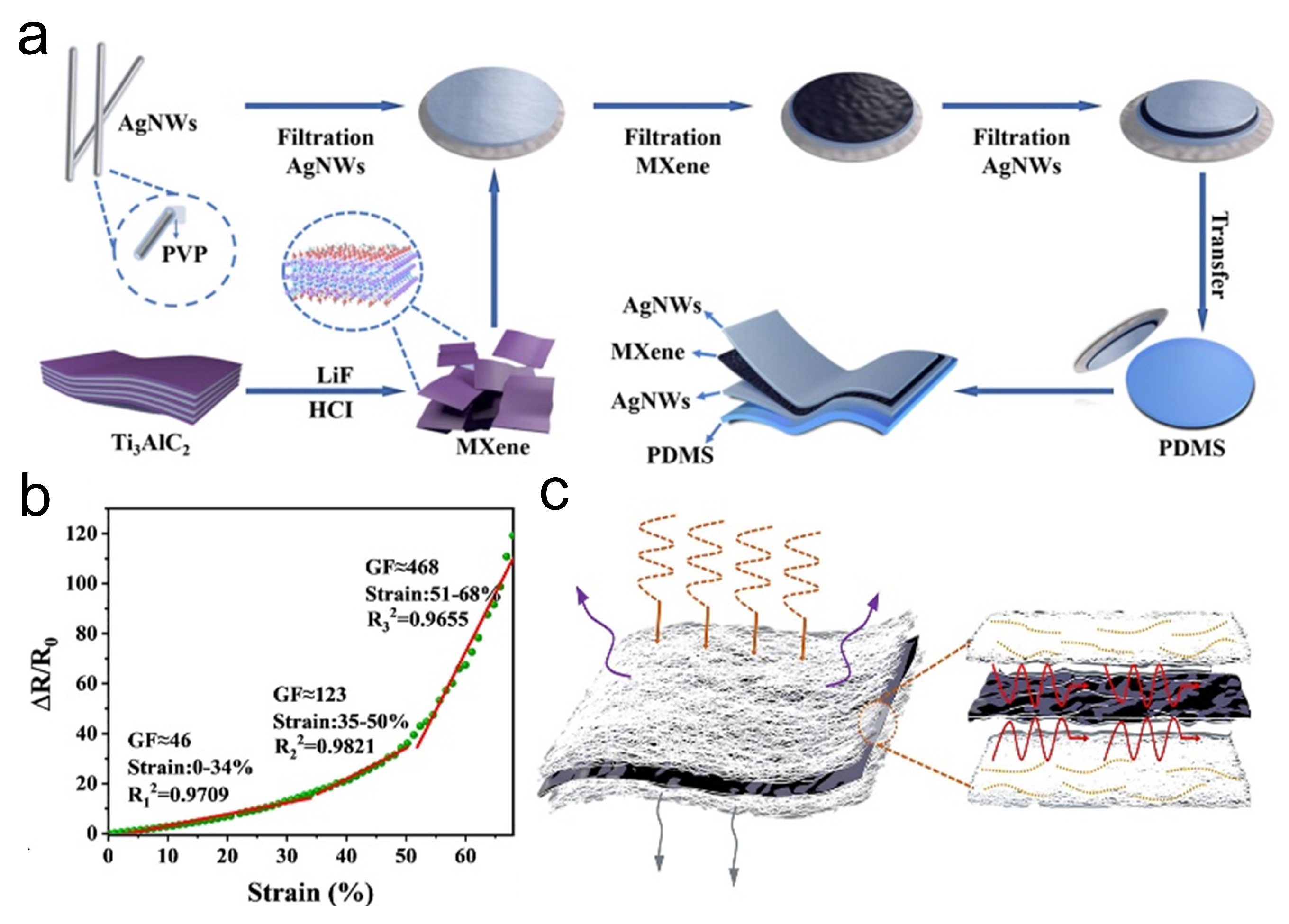
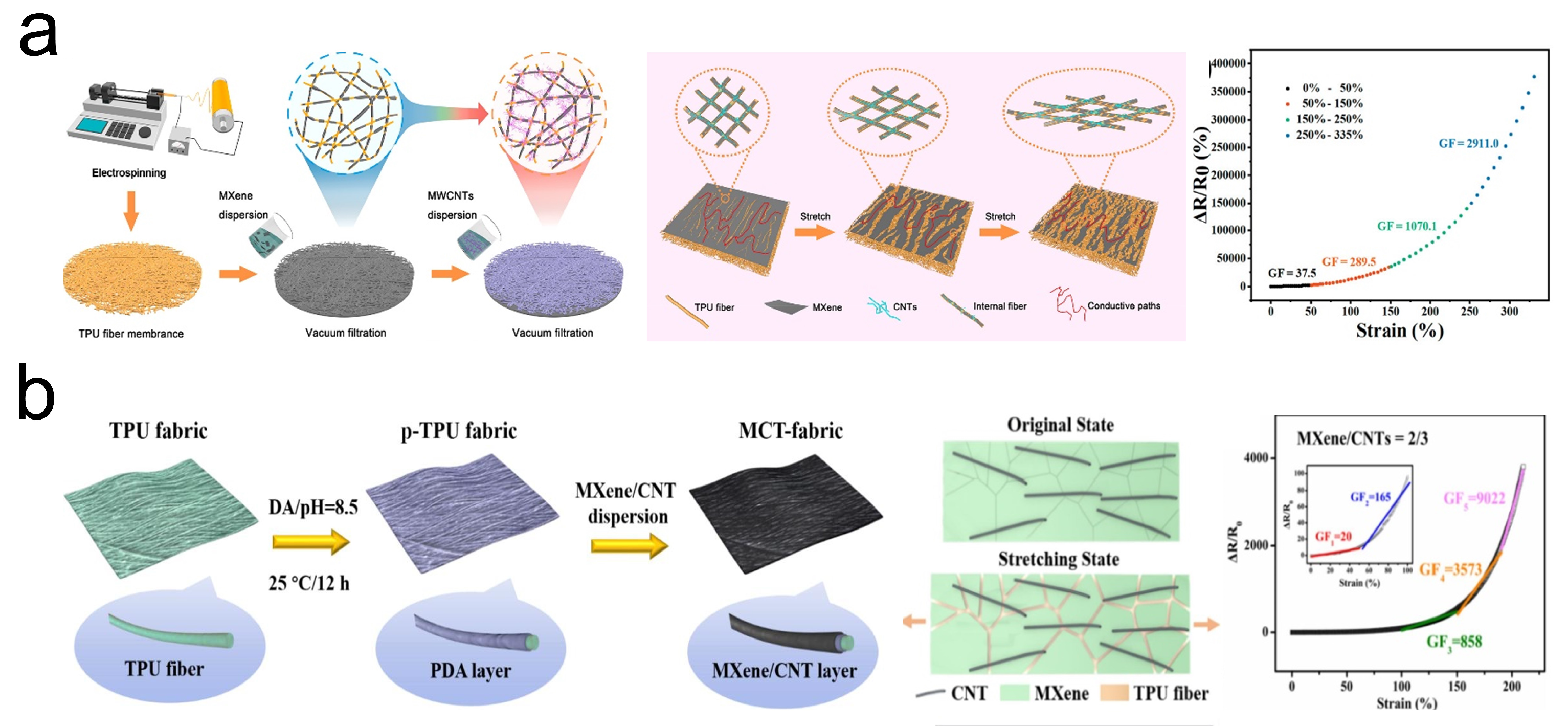
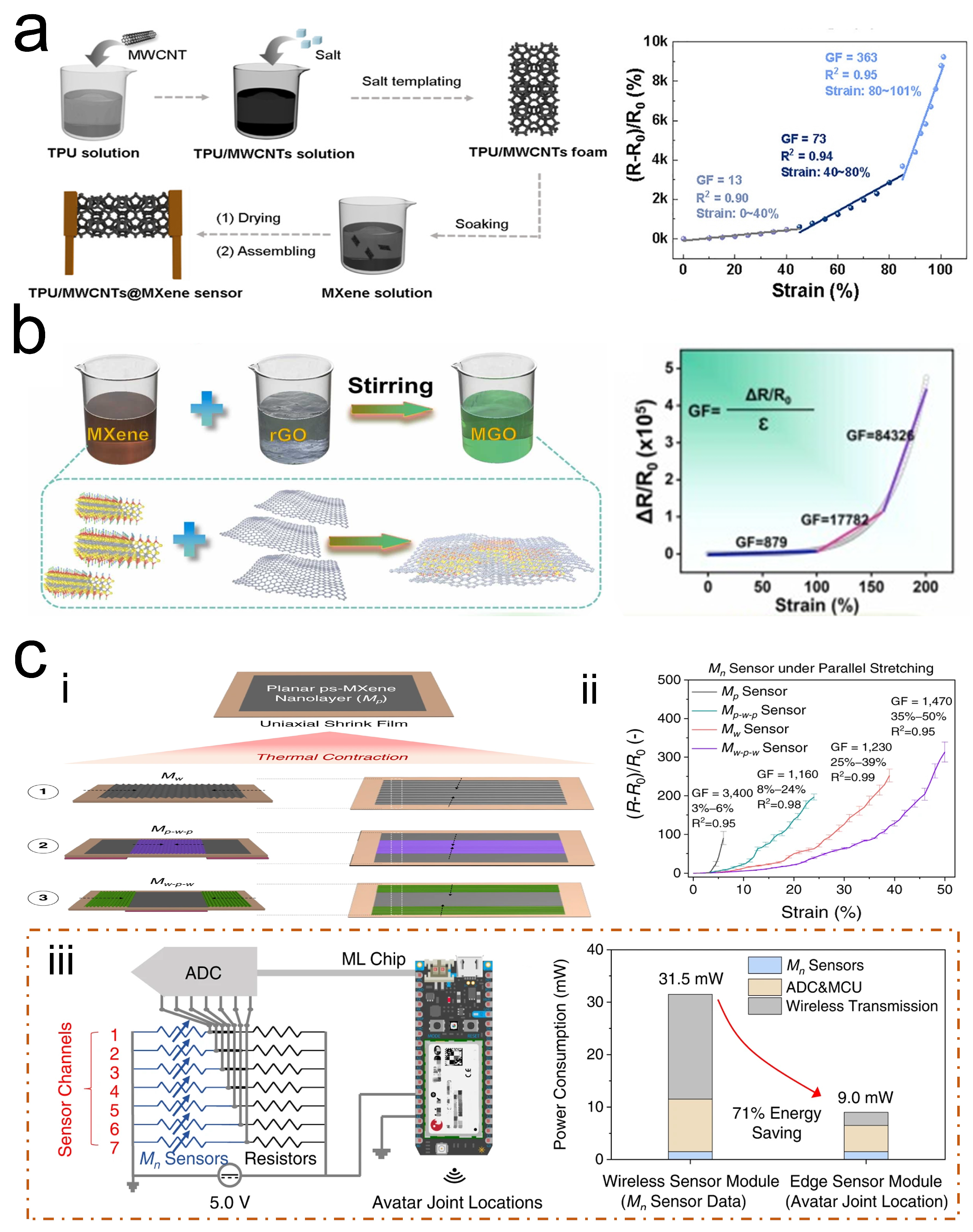



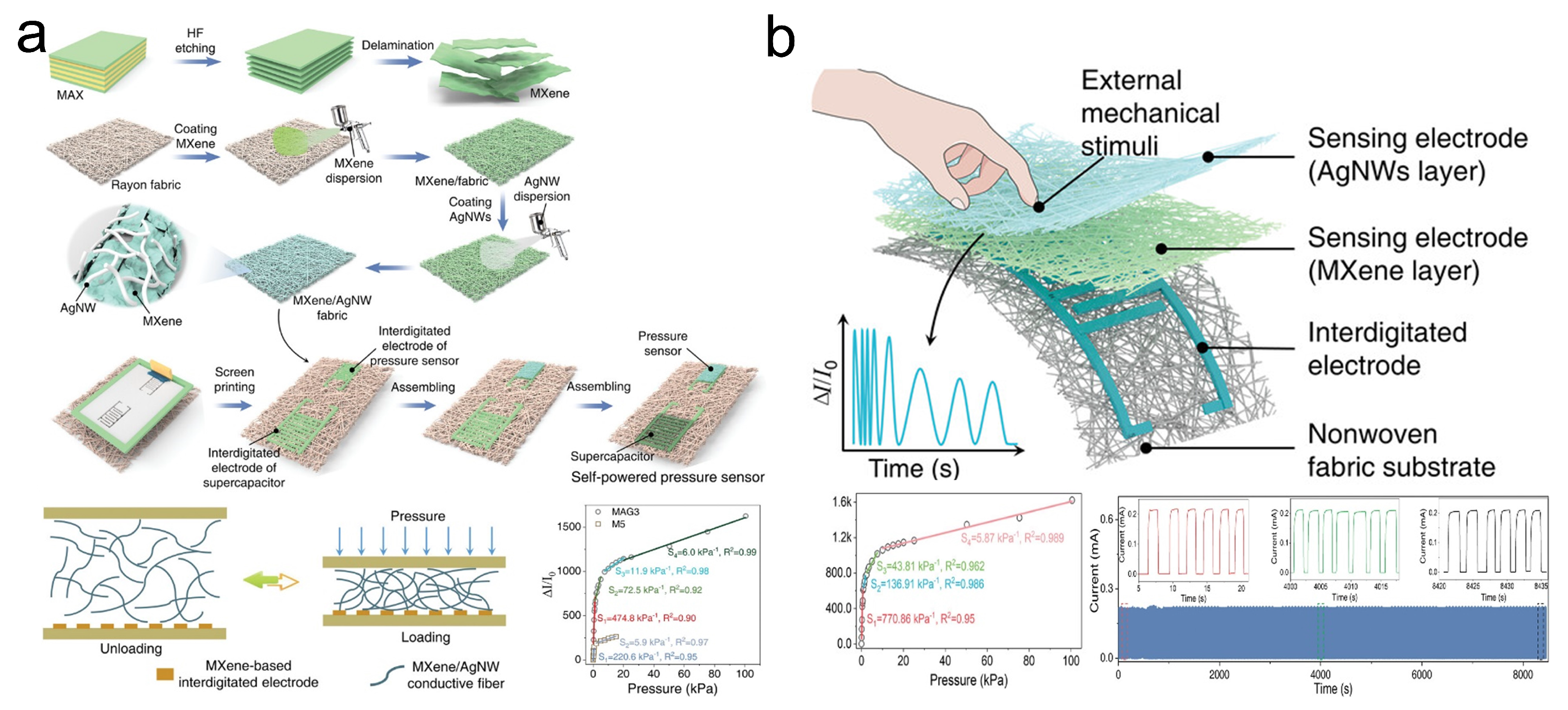
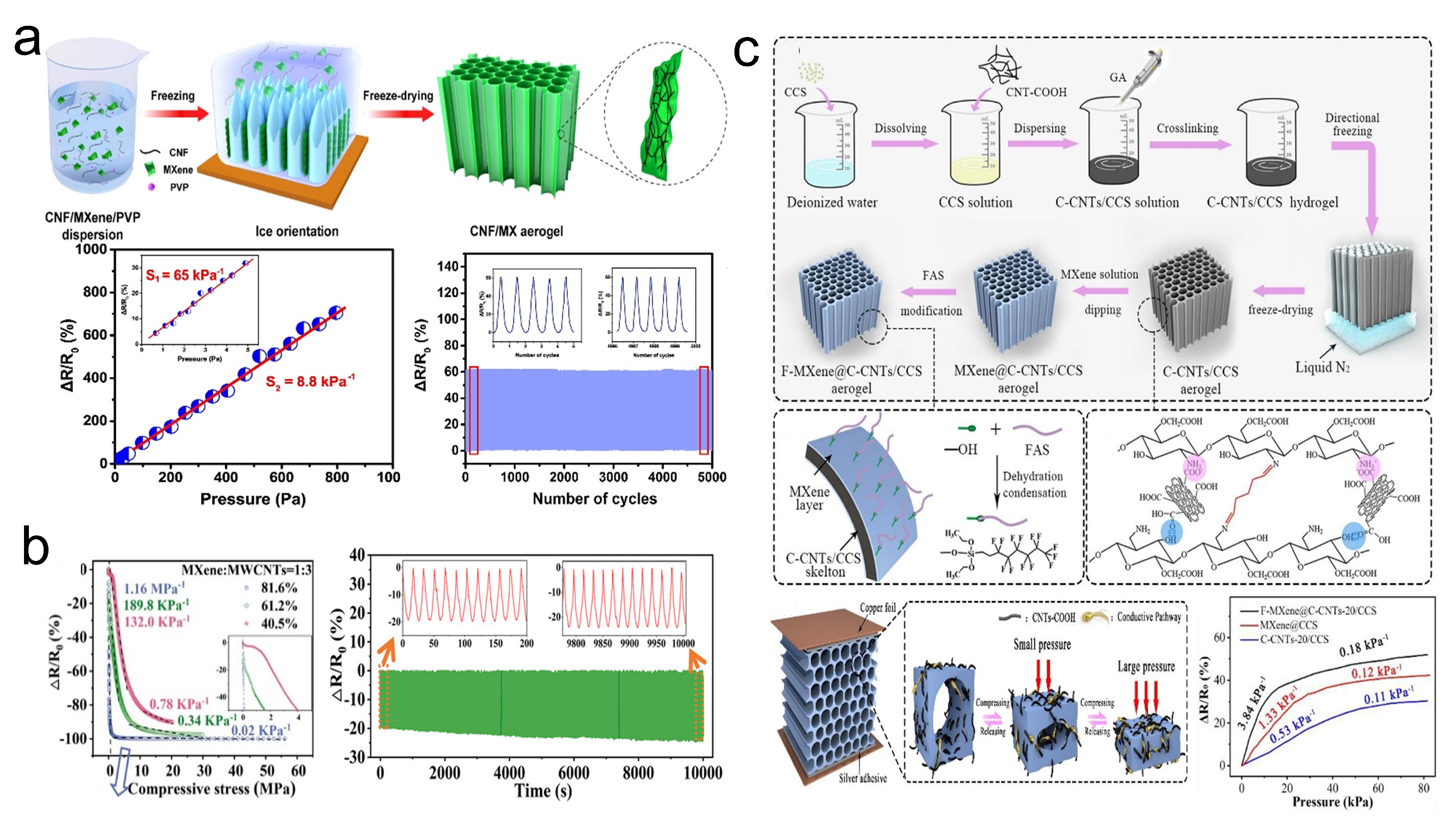
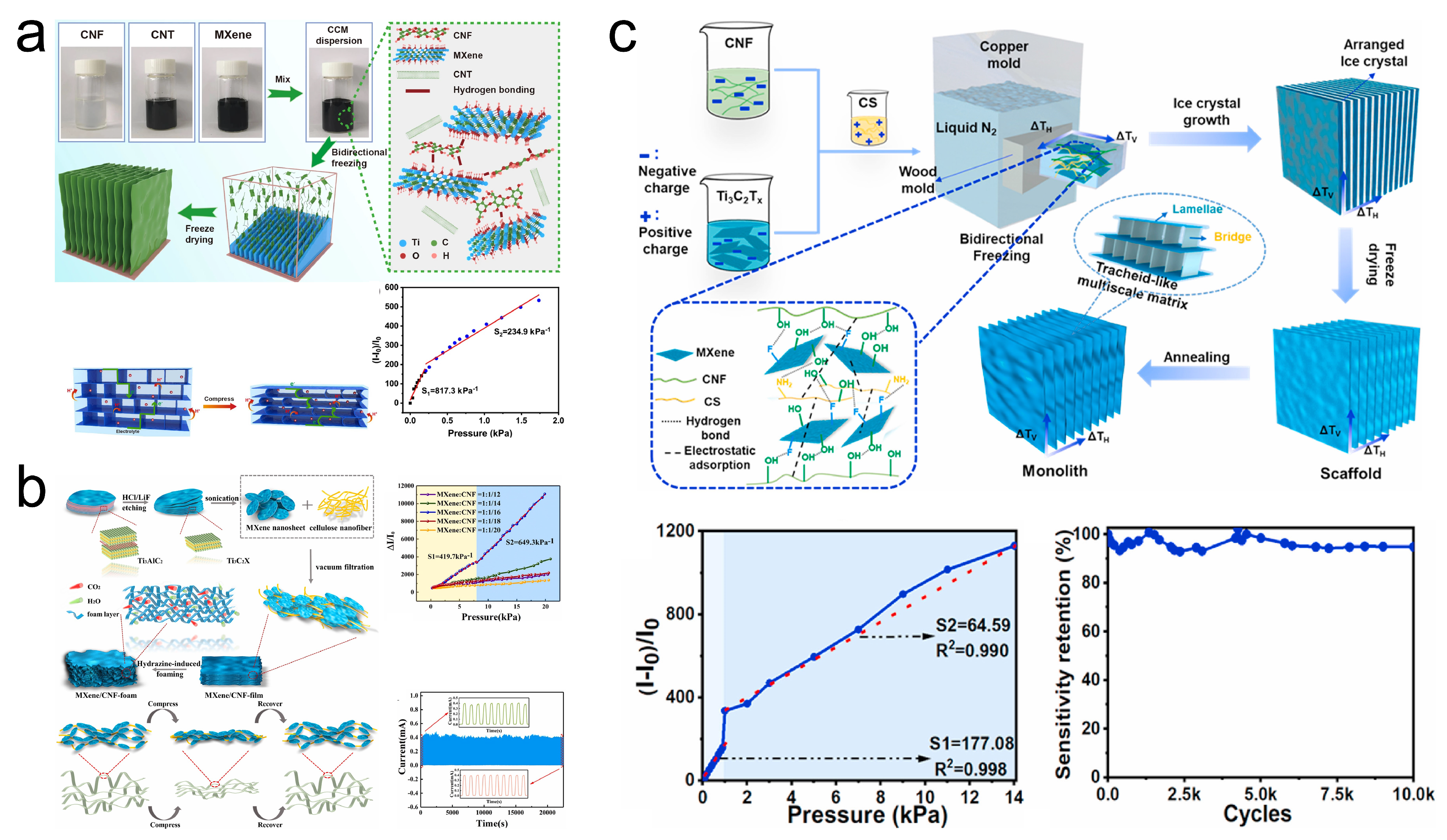


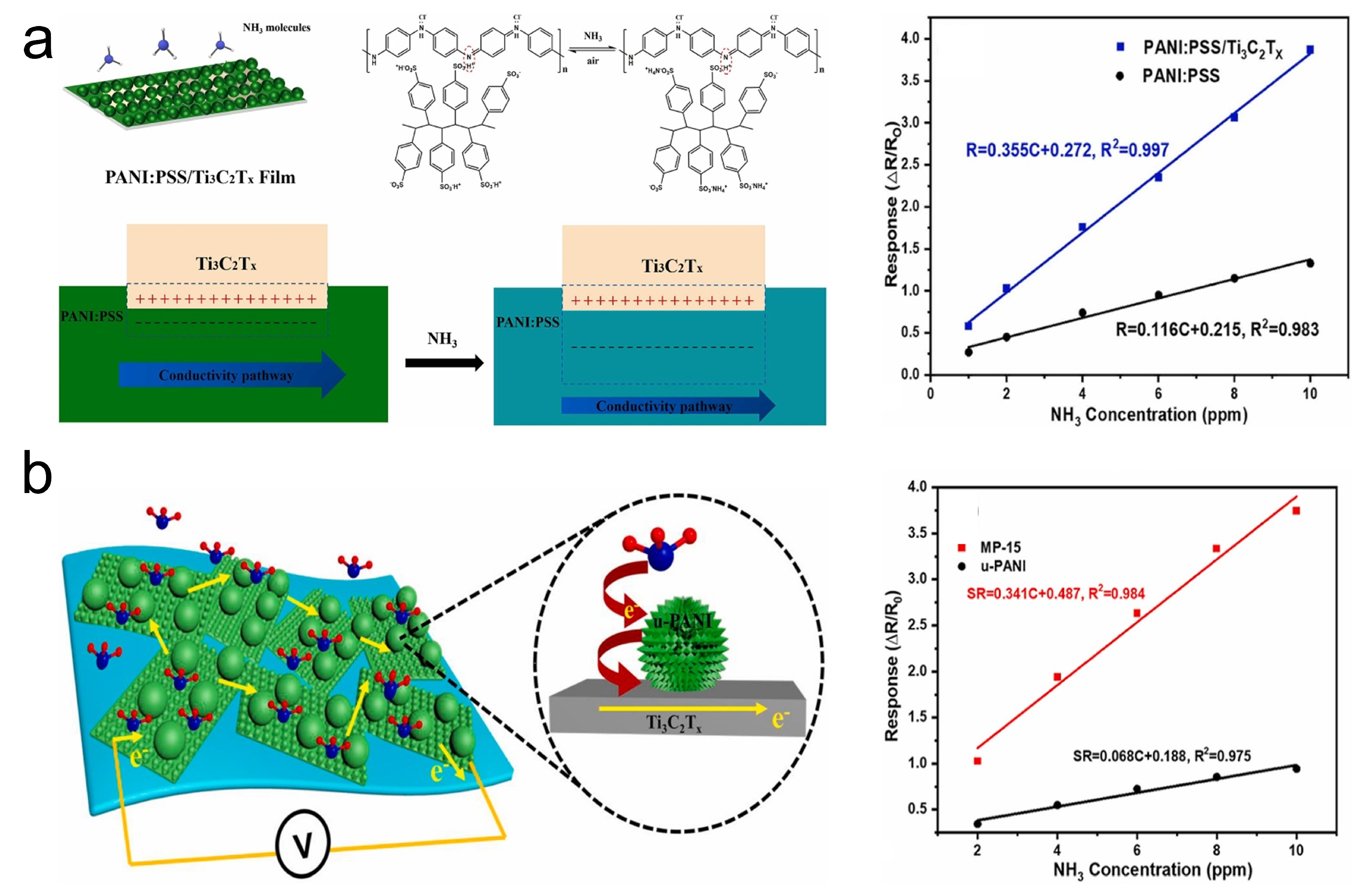
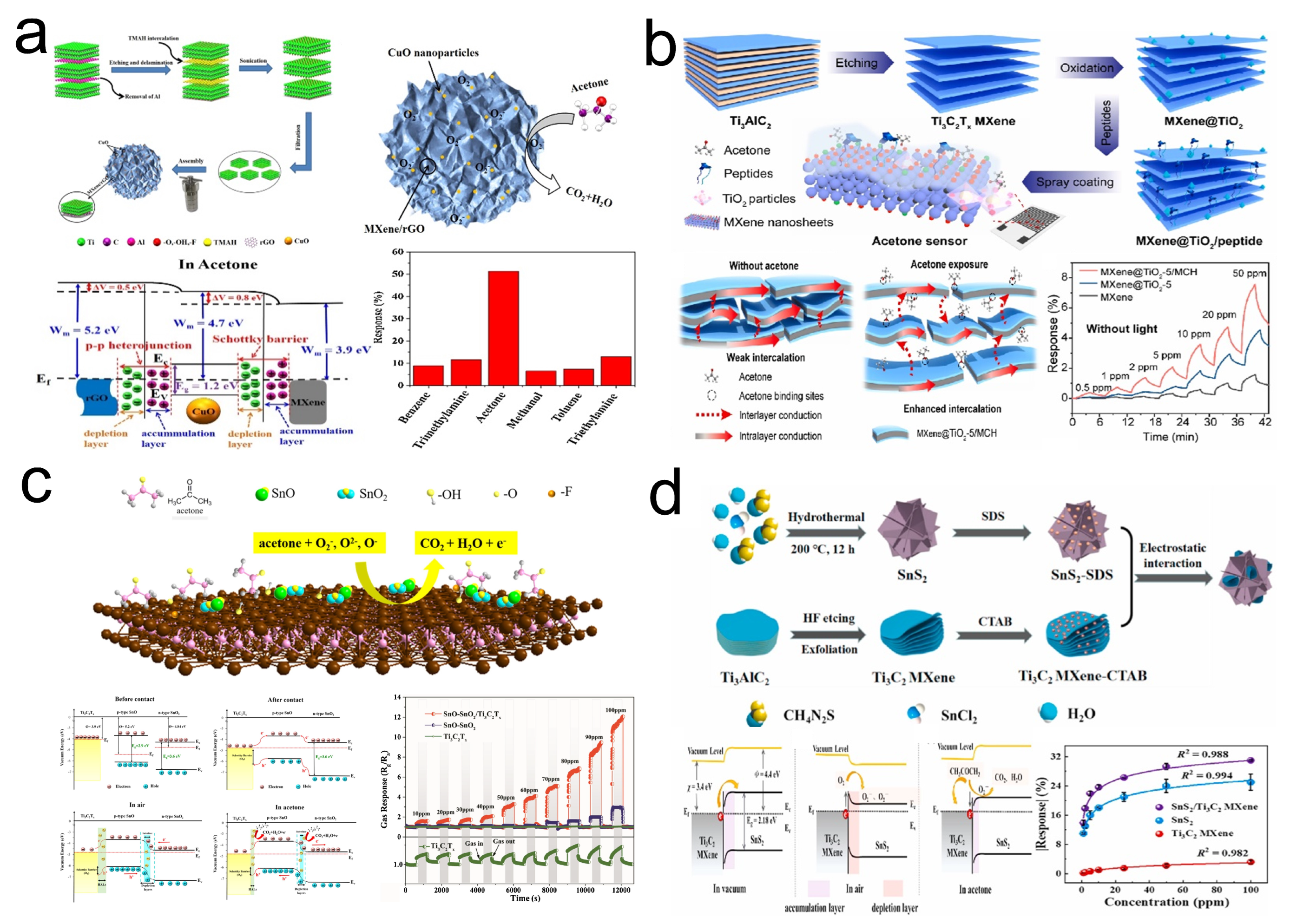
| Material | GF (Test Range) | Response Time | Recovery Time | Lowest Detection | Ref. |
|---|---|---|---|---|---|
| MXene/AgNW | 39 (25–40%) | 610 ms | 620 ms | / | [43] |
| MXene/AgNW | 1085 (80–100%) | 340 ms | 320 ms | / | [44] |
| MXene/AgNW | 4720 (80–120%) | / | / | 0.0645% | [45] |
| MXene/AgNW | 468 (51–68%) | 200 ms | / | 0.1% | [46] |
| MXene/CNT/TPU | 2911 (250–330%) | 80 ms | / | 0.1% | [47] |
| MXene/CNT | 9022 (190–210%) | 140 ms | 160 ms | 0.1% | [48] |
| MXene/multi- walled carbon nanotube (MWCNT) | 363 (80–101%) | / | / | / | [49] |
| MXene/reduced graphene oxide (rGO) | 84,326 (160–200%) | 70 ms | / | 0.05% | [50] |
| MXene/single-walled carbon nanotubes (SWCNT) | 3400 (3–6%) | 64 ms | 82 ms | / | [51] |
| MXene/CNF | 12.29 (530–800%) | 100 ms | 140 ms | / | [52] |
| MXene/CNF/ acrylic acid (AA)/acrylic acid-N- hydrosuccinimide ester (AA-NHS)/ sulfobetaine methacrylate (SMBA) hydrogel | 4.98 (1750–2240%) | 95 ms | 198 ms | 1% | [53] |
| MXene/CNF/Fe3O4 hydrogel | 0.56 (0–181.5%) | / | / | / | [54] |
| MXene/polyvinyl alcohol (PVA)/ ZnSO4 hydrogel | 5.82 (100–180%) | / | / | 3% | [55] |
| MXene/polyacrylamide/ sodium alginate hydrogel | 2.83 (0–120%) | 400 ms | 300 ms | / | [56] |
| MXene/agarose/ polyacrylamide hydrogel | 3.38% (@5%) | / | / | / | [57] |
| MXene/PVA/catechol | 2.3 (0–200%) | / | / | / | [58] |
| MXene/gelatin | 2.8 (0–100%) | 400 ms | / | / | [59] |
| Material | Sensitivity (Test Range) | Response Time | Recovery Time | Lowest Detection | Ref. |
|---|---|---|---|---|---|
| MXene/AgNW | 474.48/kPa (0–1.25 kPa) | 140 ms | 30 ms | 1 Pa | [86] |
| MXene/AgNW | 770.86/kPa (0–0.75 kPa) | 70 ms | 81 ms | 1 Pa | [87] |
| MXene/carbon nanofiber | 65/kPa (<10 Pa) | 46 ms | 26 ms | 5 Pa | [88] |
| MXene/MWCNT/TPU | 132/kPa (0–5.7 Mpa) | 260.8 ms | 176 ms | / | [89] |
| MXene/carboxylated CNT/carboxymethyl chitosan | 3.84/kPa (0–12.4 kPa) | 62 ms | / | / | [90] |
| MXene/CNF/CNT | 817.3/kPa (0–200 Pa) | 74 ms | 50 ms | / | [91] |
| MXene/CNF | 649.3/kPa (8.04–20.55kPa) | 123 ms | 139 ms | / | [92] |
| MXene/CNF/CS | 117.08/kPa (0–1 kPa) | 6.3 ms | 8.1 ms | 3 Pa | [93] |
| 3D MXene plant fiber sponge | 435.06/kPa (2–10 kPa) | 40 ms | 100 ms | 20 Pa | [94] |
| MXene/PU sponge/PVA/chitosan | 140.6/kPa (6–22 kPa) | 200 ms | 30 ms | / | [95] |
| MXene/rGO/ polystyrene (PS)/PU sponge | 224/kPa (7.58–20.65 kPa) | 63 ms | 40 ms | / | [96] |
| MXene/polypyrrole (PPy)/ PDMS sponge | 6.8925/kPa (0–15 kPa) | 100 ms | 110 ms | <0.43 Pa | [97] |
| Target Gas | Material | Response (Concentration) | Response Time | Recovery Time | LOD | Ref. |
|---|---|---|---|---|---|---|
| NO2 | 3D MXene sphere/ZnO | 41.93% (100 ppm) | 34 s | 103 s | / | [119] |
| NO2 | MXene@Au/SnS2 | 5.34 (1 ppm) | 310 s | 179 s | 0.005 ppm | [120] |
| NO2 | MXene/WS2 | 15.2% (1 ppm) | / | 70 s | 11.0 ppb | [118] |
| NO2 | MXene/SnO2 | 231% (30 ppb) | 146 s | 102 s | / | [121] |
| NH3 | MXene/polystyrene sulfonate (PANI: PSS) | 57% (1 ppm) | 276 s | 388 s | 20 ppb | [122] |
| NH3 | MXene/urchin-like Polyaniline (PANI) hollow nanosphere | 3.7 (10 ppm) | 275 s | 414 s | 30 ppb | [123] |
| NH3 | PANI/Ti3C2Tx | 55.90% (20 ppm) | / | / | / | [124] |
| Acetone | 3D MXene/rGO/CuO aerogel | 52.09% (100 ppm) | 6.7 s | 7.5 s | / | [125] |
| Acetone | MXene@TiO2-5/MCH | 7.56% (50 ppm) | / | / | 0.22 ppm | [126] |
| Acetone | MXene/SnO-SnO2 | 12.1 (100 ppm) | 18 s | 9 s | / | [127] |
| Acetone | MXene/SnS2 | 23.6 (10 ppm) | 92 s | 132 s | 5.5 ppb | [128] |
| Ethanol | MXene/Ag | 2.04 (100 ppm) | / | / | / | [129] |
| Ethanol | Ti3C2Tx/PPy/polypropylene (PP) | 76.3% (400 ppm) | 49 s | 18 s | 2.21 ppm | [130] |
Disclaimer/Publisher’s Note: The statements, opinions and data contained in all publications are solely those of the individual author(s) and contributor(s) and not of MDPI and/or the editor(s). MDPI and/or the editor(s) disclaim responsibility for any injury to people or property resulting from any ideas, methods, instructions or products referred to in the content. |
© 2024 by the authors. Licensee MDPI, Basel, Switzerland. This article is an open access article distributed under the terms and conditions of the Creative Commons Attribution (CC BY) license (https://creativecommons.org/licenses/by/4.0/).
Share and Cite
Shao, B.; Chen, X.; Chen, X.; Peng, S.; Song, M. Advancements in MXene Composite Materials for Wearable Sensors: A Review. Sensors 2024, 24, 4092. https://doi.org/10.3390/s24134092
Shao B, Chen X, Chen X, Peng S, Song M. Advancements in MXene Composite Materials for Wearable Sensors: A Review. Sensors. 2024; 24(13):4092. https://doi.org/10.3390/s24134092
Chicago/Turabian StyleShao, Bingqian, Xiaotong Chen, Xingwei Chen, Shuzhe Peng, and Mingxin Song. 2024. "Advancements in MXene Composite Materials for Wearable Sensors: A Review" Sensors 24, no. 13: 4092. https://doi.org/10.3390/s24134092
APA StyleShao, B., Chen, X., Chen, X., Peng, S., & Song, M. (2024). Advancements in MXene Composite Materials for Wearable Sensors: A Review. Sensors, 24(13), 4092. https://doi.org/10.3390/s24134092






